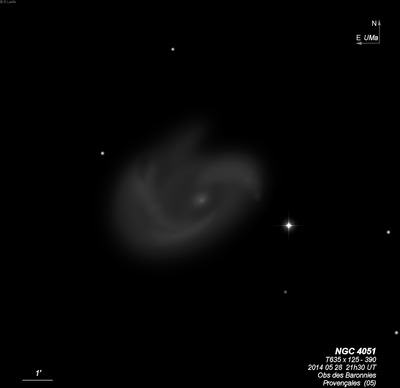
William Herschel discovered NGC 4051 = H IV-56 = h1061 on 6 Feb 1788 (sweep 810) and recorded "cB, iR, cBN with extensive chevelure about 5' dia." His position matches UGC 7030.
Bindon Stoney sketched the galaxy on 3 May 1851 as an "S" shaped barred spiral (in LdR's 1861 publication). He captured the structure very accurately and noted, "Spiral. I suspect the f branch extends to [star] alpha [on the northeast end]." On 19 Apr 1857, R.J. Mitchell logged "The p branch seems to me the brighter rather of the two, and more suddenly curved than the f one, both of them look not quite so sharp as given in the drawing."
NGC 4051 is one of the original 6 galaxies studied by Seyfert in his seminal 1943 paper "Nuclear Emission in Spiral Nebulae".
400/500mm - 17.5" (3/8/97): fairly bright, large, ~4.0'x2.5' NW-SE. Nearly extends to a mag 11 star 2.2' W. Very bright, very small core increasing to a bright stellar nucleus (original Seyfert galaxy list). The galaxy shows signs of spiral structure and there appears to be a short outer spiral arm attached at the SE end hooking north separated by a slightly darker region between the main body (verified on photo). This galaxy, along with NGC 3938 and NGC 4111, are the brightest members of the NGC 4111 group (LGG 269) in the UMa Cloud.
900/1200mm - 48" (5/10/18): at 375x; NGC 4051 is a highly structured S or Z-shaped barred spiral with easy HII knots and subtle details! This Seyfert galaxy is very sharply concentrated with a brilliant quasi-stellar nucleus! The bright core extends into a slightly brighter central region or bar elongated 2:1 NW-SE and just over 1.5' in length. The halo extends at ~4.5'x3.5' NW-SE.
A very obvious eastern arm is attached at the southeast end of the bar and angles at a 90° angle towards the northeast, pointing towards a mag 14.0 star [2.8' NE of center]. A low surface brightness thin arm [roughly 1.6' in length] angling SE to NW was visible on the north side. On the DSS this arm appears to emanate from the bright eastern arm though visually it appeared straight and completely detached.
A large knotty arm, attached at the northwest end, bends sharply towards the south. This arm is thick or wide at its root with a large brighter knot or region embedded (catalogued as [EKS96] #31 and #28 in the 1996 "Atlas of HII Regions in Nearby Seyfert Galaxies"). As the arm dips south it terminates at a faint 10" knot (#10), 1.4' W of center. In addition, an obvious, small bright knot (#52), ~8" diameter, is just south of the core [by 0.6']. This knot resides in a very thin arm (not seen) just south of the central region. Overall, I was very impressed with this gorgeous galaxy!
Notes by Steve Gottlieb